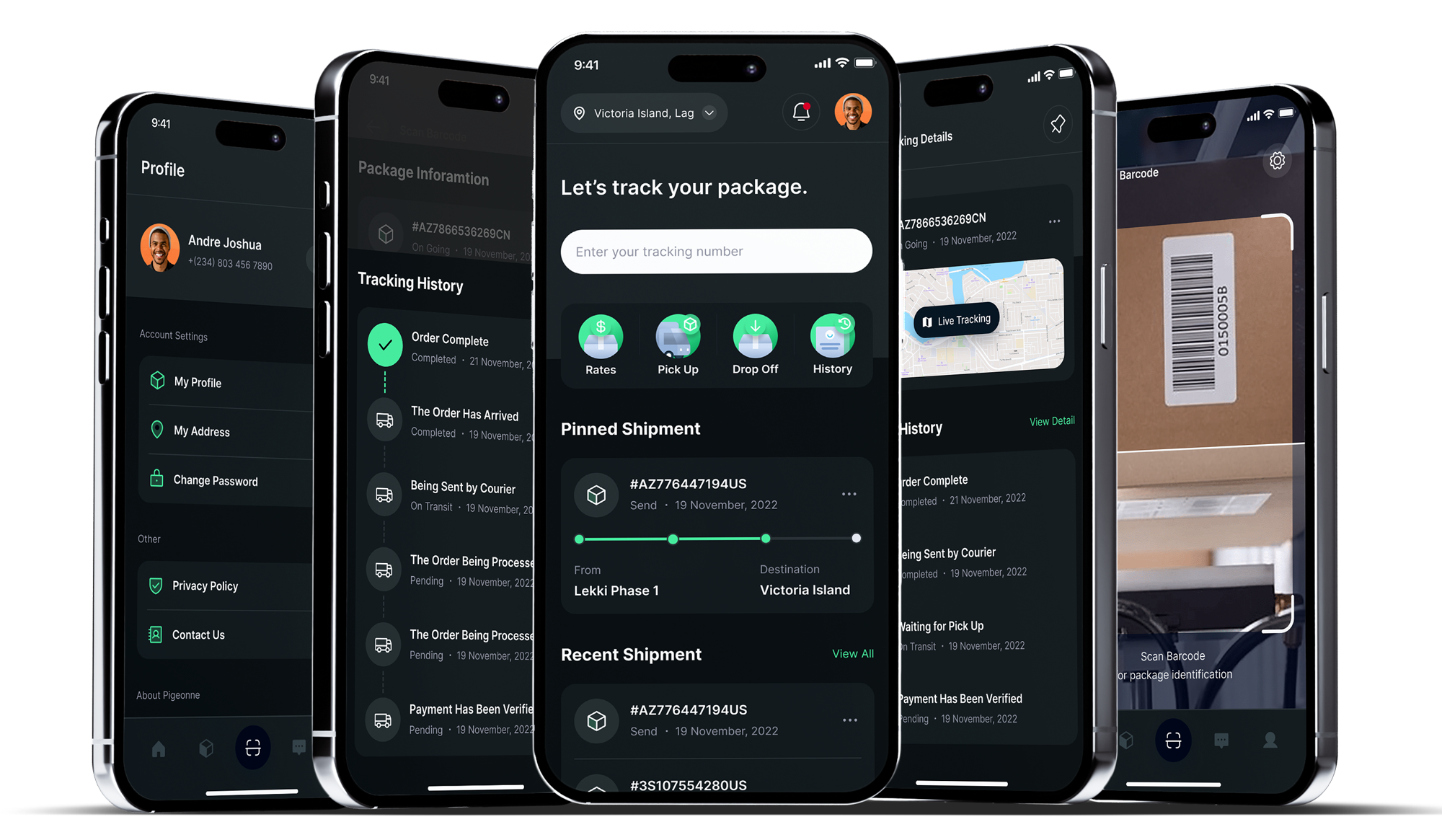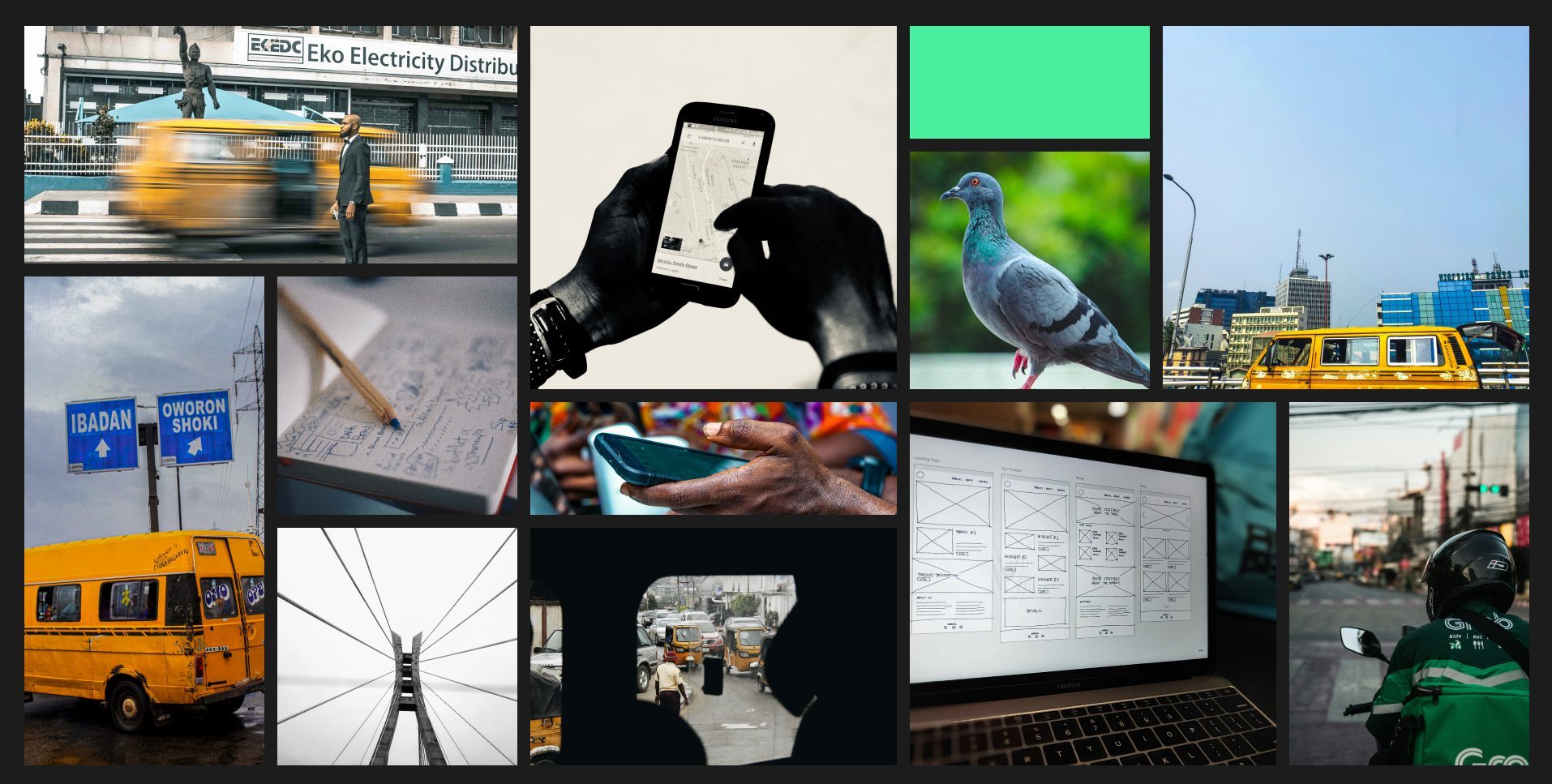Rethinking
Logistics & Delivery
Experiences
Role
Research
Product Strategy
UI/UX Design
Branding
Duration
4 Months
Deliverables
High-fidelity Mockups
User Research
Tools
Figma, FigJam, Adobe CC
Google Meet, Notion

Context
In Lagos, and Nigeria at large, last-mile delivery logistics is as popular now as it’s ever been, and today’s market offers plenty of app options to make the process of dispatching items easy and intuitive. However, I believe there is still plenty of untapped potential and opportunity in this space to provide a unique experience—but more importantly—alleviate the problems users currently have with these apps and services.
Problem
Online delivery services in Lagos have high prices and long pickup/delivery times, which both result in users placing fewer orders on average per week.
Goals
USER GOALS
- Decrease pickup/delivery time.
- Reduce prices.
- Avoid traffic
BUSINESS GOALS
- Increase weekly orders to 3 or more times a week per user
- Remain profitable
Research Insights
To identify problems that exist within online delivery apps and the process of ordering a delivery service, I created a survey with questions to discover the motivations behind a user’s decision on whether or not to place an order.
After surveying a total of 50 people and analyzing their responses, I discovered two main reasons that kept users from placing orders:
High Delivery Prices
Long Pickup/Delivery Times
Users who complained about high prices did not list long delivery times as a concern. Conversely, users who complained about long delivery times did not consider high prices a concern.
KEY INSIGHTS FROM SURVEY RESPONSES
- 56% of participants said one reason they choose to not send packages using online delivery apps is that “It’s too expensive”—with ~25% of participants stating the delivery times are too long.
- When answering the question “What are the most important factors when deciding whether or not to place an online delivery request on a delivery app?” 56% answered “Price” with 36% answering “How long the trip will take”.
Competitive Analysis
Today’s app marketplace features no shortage of online delivery apps. In addition to using these types of apps heavily during the first half of 2022, a Competitive Analysis was performed to learn more about how these apps handle the two frustrations (high prices and long pickup/delivery times) that users reported in my survey.
Below is a summary of how five of today’s leaders in online delivery (Gokada, Uber Connect, Kwik, GIGL, and Max.ng) are rated based on different criteria.

Open the Notion document to view the full Competitive Analysis, including other measured factors such as brand elements, UX, app screenshots and more.

App Concept & Creation



After analyzing the survey results and competitive analysis, it was evident that the 2 user frustrations, high prices, and long delivery times, were not being solved by the current online delivery apps on the marketplace today.
In addition, it had become clear that each of these problems were tied to each other, and could be solved from a business/product perspective. Ultimately, the solutions developed would alleviate both problems. These solutions came in the form of a new online delivery app service: Pigeonne.
What is Pigeonne?
Pigeonne is a concept online delivery app built from the ground up. Pigeonne’s primary purpose is to alleviate user’s frustrations with high prices and long delivery times with simple and intuitive solutions.
On the surface, Pigeonne operates the same as we’ve come to expect with delivery apps: Select a pickup address, choose package type, and enter a delivery address. However, the app also offers two innovative experiences for those who engage in them.
To better understand both user problems, it was imperative to create user personas for each and develop solutions from an informed perspective.
User Persona 1

To better understand how to design for users seeking discounts/rewards or shorter wait times, User Personas were created for each type of user.
Below is a brief version of Amina’s persona, a 34-year-old business owner motivated to streamline her e-commerce operations and maintain a positive business reputation by utilizing delivery apps for efficient and timely parcel shipments. She values accurate and real-time tracking to manage customer expectations and address inquiries promptly. Amina’s frustrations arise from the unreliability of some delivery services, causing delays and subsequent customer dissatisfaction. Her goals include finding a user-friendly app with efficient route planning, ensuring seamless business operations, and enhancing customer satisfaction.
Amina was used to understand a user who would care more about seeking faster deliveries than cheaper ones.
Amina Magaji
- 34 years old
- Lives in Lagos
- Owns a Fashion Business
- Monthly Revenue: N700k+
- Averages 9 shipments per day
Use Case
- Shipping Frequency: 6-11 times per day
- Creating Shipments: Frequently uses delivery apps to send out parcels of her products to customers.
- Real-time Tracking: Relies on accurate and real-time tracking to manage customer expectations and address delivery-related inquiries promptly.
- Efficient Route Planning: Given the unpredictable Lagos traffic, Amina values apps that optimize delivery routes for swift and timely deliveries.
- Onboarding Ease: Seeks a user-friendly onboarding process that allows her to quickly schedule and manage shipments without any technical complications.
- Address Management: Managing multiple delivery addresses is crucial for Amina to cater to her diverse customer base and ensure accurate deliveries.
User Persona 2

Tunde, a 29-year-old banker, is motivated to efficiently manage his workday without interruptions by using delivery apps to order lunch and make purchases during tight work schedules. He values accurate tracking to know precisely when his deliveries will arrive, allowing him to step away from his desk at the right time. Tunde’s frustrations stem from the time-consuming process of leaving the office, navigating Lagos traffic, and the lack of efficient route planning in some apps. His goal is to integrate meal orders into his busy schedule seamlessly, ensuring timely and satisfying meals without compromising work efficiency.
Tunde Richards
- 29 years old
- Lives in Victoria Island, Lagos
- Works in a New Generation Bank
- Finishing Master’s Degree online
- Monthly Salary: N400k
- Averages 5 shipments per week
Use Case
- Ordering Lunch: Tunde, a 29-year-old banker, uses delivery apps to order lunch as he cannot afford to leave work during the hectic day.
- Real-time Tracking: Tunde values real-time tracking to know exactly when his lunch will arrive, ensuring he can step away from his desk at the right time.
- Quick Onboarding: Tunde prefers apps with a straightforward onboarding process that allows him to quickly place orders without disrupting his work.
- Efficient Route Planning: Given the tight schedule and Lagos traffic, Tunde appreciates apps that optimize routes for quick deliveries.
- Messaging Support: Tunde seeks an app with a reliable support system, allowing him to quickly resolve any issues or make special requests for his orders.
Early Iterations / Sketches



The original goal of Pigeonne was developing an intuitive way for users to select their “Delivery Type” and explore different delivery speed/pricing options. Some of the early ideas included putting a “Delivery Type” modal to forecast available delivery options alongside the duration and cost.
At this time, the concept of “Delivery Types” has been implemented for users like Amina who prioritize speed over cost.
User Flows

The main point of constructing this user flow was to ensure that the delivery ordering process would be intuitive to use and that the different delivery options are presented to the user in a less obstructive way. I decided that the best way to execute this was buy placing the pricing and timeframe details in a bottom sheet right before checkout. Using this flow made the ordering process simple and straight forward.
Wireframes

For the users who were mostly concerned with long wait times, a custom order experience and express service was developed to suit their preference.
Hi-fidelity Prototype



The original goal of Pigeonne was developing an intuitive way for users to select their “Delivery Type” and explore different delivery speed/pricing options. Some of the early ideas included putting a “Delivery Type” modal to forecast available delivery options alongside the duration and cost.
At this time, the concept of “Delivery Types” has been implemented for users like Amina who prioritize speed over cost.

 View user flow on Whimsical
View user flow on Whimsical